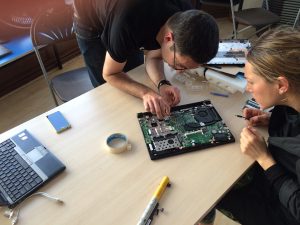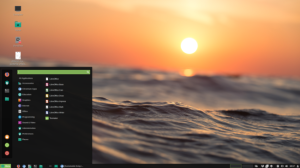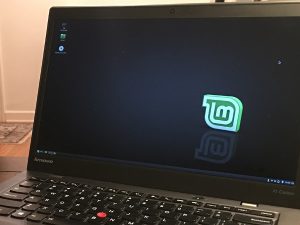Have a feeling your device is on its last legs and dreading the day you might have to consider buying a new one? Sophie Paterson shares top tips to keep your technological devices ticking, starting with how to extend the lifetime of your laptop.
Whether working from home or learning from home right now, our computers have, for better or worse, become lifelines, with the thought of having to replace them likely to fill us with dread. At the same time, the environmental implications of producing a constant stream of new devices are significant: this life cycle analysis suggests 3,010 to 4,340 megajoules of primary energy is required to produce a laptop, taking it from unmined materials through to a product ready to sell.
So, aside from the obvious of not accidentally spilling our choice of hot beverage over them, how can we make sure that these precious tools keep going as long as possible?
Switch your operating system
Switching to an open source operating system like Linux is one way to prolong the life of an ageing laptop. I’ve seen the benefits firsthand, with a laptop of mine now into its second decade, having made the switch to Linux seven years ago as a complete novice. Even better, it’s free to download, free to install and doesn’t harvest your data in the same way that proprietary software – Windows very much included – does. What’s not to love?
There are several ways you can achieve this:
- Installing Linux alongside Windows on your device – see here
- Starting from scratch with just Linux – see here
If you’re not quite sure how you’ll get on, it might also be helpful to take Linux for a test-drive first, while this article from my colleague Dave is a gentle introduction to learning how to use Linux as a beginner.
Putting Linux on it can add 5 to 10 years of useful life to a sluggish Windows machine.
Simon Lennane (So long, Doris: how to build a Linux computer from scratch)
Revive with a solid-state drive
A top tip from Kris De Decker of Low-tech Magazine is to couple your switch to low-energy software, such as a Linux Lite operating system, with a switch from a hard drive to a solid-state drive, as explained below.
Although you can revive an old laptop by merely switching to a light-weight operating system, if you also replace the hard disk drive with a solid-state drive, you’ll have a machine that is just as fast as a brand new laptop. Depending on the storage capacity you want, an SSD will cost you between 20 euro (120 GB) and 100 euro (960 GB).
Installment is pretty straightforward and well documented online. Solid-state drives run silently and are more resistant to physical shock, but they have a shorter life expectancy than hard disk drives. Mine is now working for almost 4 years. It seems that both from an environmental and financial viewpoint, an old laptop with SSD is a much better choice than buying a new laptop, even if the solid-state drive needs replacement now and then.
Kris De Decker (How and why I stopped buying new laptops)
Be selective about where you save
If switching to a solid-state drive isn’t feasible, Kris has a further hardware upgrade tip that facilitates the use of old laptops (and also new ones): storing your data using the small but mighty SD-card (assuming your older laptop has a slot for them). Kris’ system also has the added benefits of protecting against data loss.
Many people have their personal documents stored on their laptop’s hard drive and then make backups to external storage media if all goes well. I do it the other way around. I have all my data on a 128 GB SD-card, which I can plug into any of the Thinkpads that I own. I then make monthly backups of the SD-card, which I store on an external storage medium, as well as regular backups of the documents that I am working on, which I temporarily store on the drive of the laptop that I am working on. This has proven to be very reliable, at least for me: I have stopped losing work due to computer problems and insufficient backups.
The other advantage is that I can work on any laptop that I want and that I’m not dependent on a particular machine to access my work. You can get similar advantages when you keep all your data in the cloud, but the SD-card is the more sustainable option, and it works without internet access. Hypothetically, I could have up to two hard drive failures in one day and keep working as if nothing happened. Since I am now using both laptops alternately – one with battery, the other one without – I can also leave them at different locations and cycle between these places while carrying only the SD-card in my wallet. Try that with your brand new, expensive laptop. I can also use my laptops together if I need an extra screen.
In combination with a hard disk drive, the SD-card also increases the performance of an old laptop and can be an alternative to installing a solid-state drive. My spare laptop does not have one and it can be slow when browsing heavy-weight websites. However, thanks to the SD-card, opening a map or document happens almost instantly, as does scrolling through a document or saving it. The SD-card also keeps the hard disk running smoothly because it’s mostly empty.
Kris De Decker (How and why I stopped buying new laptops)

Credit: Heliberto Arias on Unsplash
Maintain and repair as much as possible
Maintaining your laptop can mean anything from ensuring timely software updates to ensuring it doesn’t over-heat – common sense actions which are sometimes easy to take for granted but which will prolong the lifetime of your device. Some issues associated with ageing machines will of course require actual repair – an ageing laptop fan, for example. If you’re keen to tackle it yourself, websites such as wiki-based site iFixit are a fantastic resource (and not just when it comes to laptops). Alternatively a trip to your local independent repair shop will suffice. Other options for repair would in normal times include Restart Parties from The Restart Project, but these are sadly cancelled due to the COVID-19 pandemic right now, except for a few which have moved online.
Meanwhile, inspiring stories abound from organisations championing the right to repair, to the benefit of families struggling to meet the demands of online learning from home and individuals at risk of social isolation without access to a device. Borrow Don’t Buy, a Library of Things in Plymouth forced to shut during lockdowns, have continued their great work by collecting donations of older technology to refurbish and repair them. They then box them up better than new, and, working with partners across the city, give them away to people who need them.
Ready to give your laptop another chance?
Hopefully you’re now feeling a little more optimistic about the prospects for your much-loved laptop. But what if the worst happens and it’s impossible to bring back to life? You can still re-use parts of your old machine and continue to put them to good use. Here’s how Simon did it. If this isn’t an option, responsible recycling is a must when it comes to electronics. You can find your nearest eletronics recycling point courtesy of Recycle Your Electricals – but we hope you won’t have to!
How to extend the lifetime of your laptop: further resources
- Low-impact IT and Free & open source software – our dedicated topic introductions with links to articles, books and more
- Low-impact & the city (Parts 5, 8, 9 10 & 11) – our Dave’s journey to switching to Linux as a non-techie
- So long, Doris: how to build a Linux computer from scratch – Simone Lennane shares his experiences repurposing a beloved old laptop
- How and why I stopped buying new laptops – an excellent article courtesy of Kris De Decker’s Low-tech Magazine
- Fighting for the right to repair electronic devices – an illuminating overview from Ethical.net
Main image by Joshua Woroniecki on Unsplash.
Have any top tips of your own to share? Let us know in a comment below.
 About the author
About the author
Sophie Paterson is a co-director at Lowimpact.org and NonCorporate.org, where she looks after promotion, social media, the blog and more. A graduate of the School of Natural Building, she lives in Totnes, Devon, having previously spent a year living and volunteering on a nearby smallholding.








2 Comments
Was wondering if this article would be Open Sourced based – AND IT IS! Yippee. Been using Linux Mint for lots of years (Mint 20 has issues with HP printers!) and an Solid State drive really does do the business! AND you can run graphics heavy software – FreeCAD and Blender particularly- which is a boon to publishers! Oh, it’s ‘possible’ to run Windows based software (why bother?) except for Sketchup. But Blender will now perform as well as Sketchup but with a longer learning curve. Can recommend Scribus for DTP!
My 2010 MacBook (white unibody) just got a 8G RAM and 500G SSD update, and I also replaced the trackpad using parts from a laptop that a friend was throwing out. My 2010 had arithitis so bad that I was worried it wouldn’t make it to bathroom in time. Now it is faster than a 2012 MacBook Pro that I compared it too (that had an HD in it but a upgraded RAM). I am excited to see how long it will last.